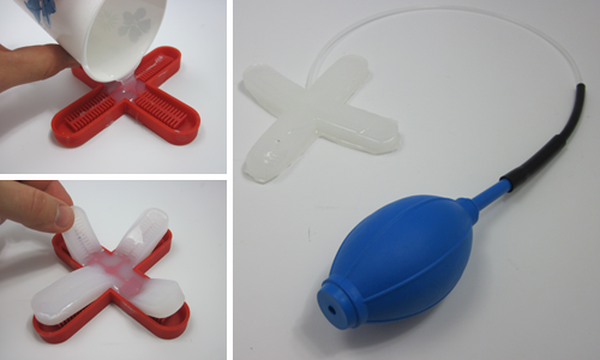Soft Robots: Alternative Robot Design
Robotics engineers are experimenting with soft robots and robots modeled after biological organisms. With a squishy project at Science Buddies, students can get in on the action and test their own soft, air-powered, robot.
A recent story in MIT News shows off a cool robotic fish and highlights the softer side of robotics. This new wave of robotics research explores the benefits and possibilities of robots that sport softer, less angular exteriors, designs often inspired by biological systems and organisms.
Designers of soft robots, like the robotic fish developed by the Distributed Robotics Laboratory, take a different approach to constructing the robot's exoskeleton and thinking about how the robot will move and interact with its environment. For example, a soft robotic fish, modeled after a real fish, can bump into things in its environment differently than a more traditional hard and angular robot. A soft robot may also be able to navigate areas that a more rigid-bodied robot cannot, and a soft robot that runs into something may cause less harm and suffer less damage.
Making Connections
Students curious about robot design and about soft robots can get started exploring principles of soft robotics by making their own gripper robot. In the Squishy Robots: Build an Air-Powered Soft Robotic Gripper robotics engineering project, students use a 3D printed mold and liquid silicone rubber in the construction of a gripper that can curl around and "grip" an object. What advantages does this soft-bodied construction have over other kinds of robotic grippers?

For a look at creating a more humanistic robotic hand, see the Grasping with Straws: Make a Robot Hand Using Drinking Straws project. Using straws, students are challenged to design and construct a robotic hand, with bendable appendages, that works using a system of threaded joints. How many "fingers" does a robotic hand need? At how many points does it need to bend? What mechanism will cause the hand to bend, move, and grip?
Understanding and identifying the need or task for a robot is important in making robot design decisions. What does the robot need to pick up? How small are the items? How heavy are they? What does it need to do with them once it has grabbed them? Other questions to ask involve where the robot will be used. A robot being used in an underwater environment, for example, will have very different design requirements.
These are questions and issues engineers must consider as part of the engineering process when designing a robot. Will the best solution be hard or soft? Experimenting to better understand how varying approaches work is a first step for students getting started with robotics.
Additional information:
- Students doing the Grasping with Straws: Make a Robot Hand Using Drinking Straws project and ready to take their design to the next level can explore the integration of servo motors and microprocessor boards, like ArduinoTM, to further control and automate their robots.
- For more information on the ways in which engineers are borrowing designs from other animals, see Bio-inspired Robotics Engineering: Taking a Cue from Insects.
- To experiment with building a different kind of underwater robot, see the Build a Simple Underwater Robot project.
Categories:
You Might Also Enjoy These Related Posts:
- Plastics and Earth Day - Science Projects
- Arduino Science Projects and Physical Computing
- 10+ Robotics Projects with the BlueBot Kit
- 5 STEM Activities with Marshmallow Peeps
- March Madness Basketball Science Projects: Sports Science Experiments
- Women in STEM! More than 60 Scientists and Engineers for Women's History Month
- Explore Artificial Intelligence and Machine Learning with Student AI Projects
- 10 Reasons to Do the Rubber Band Car Engineering Challenge









